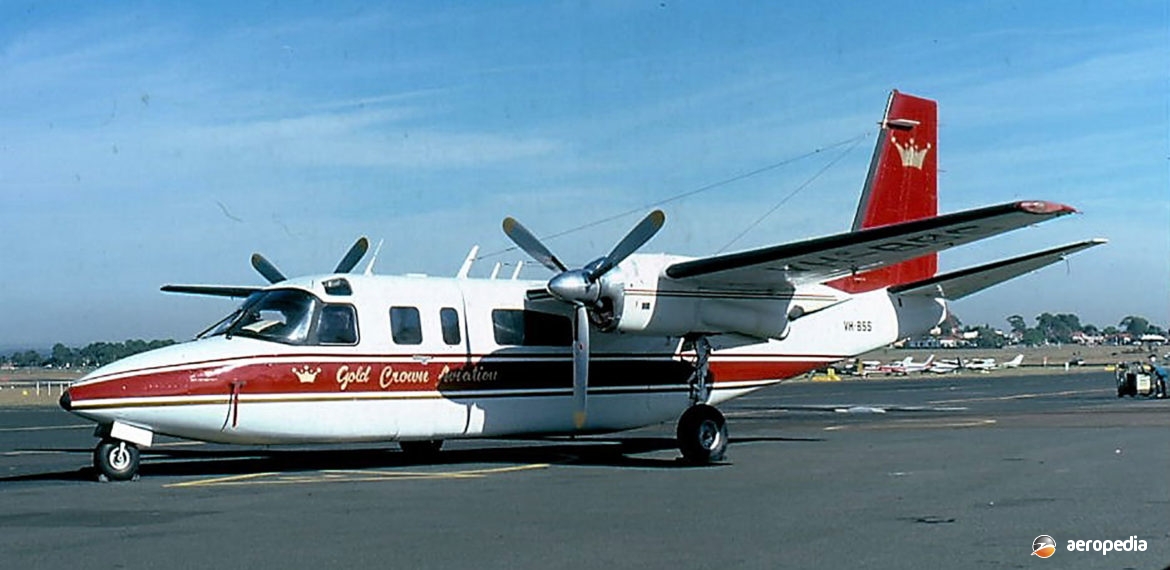Photograph:
Aero Commander Rockwell 690 Turbo Commander VH-BSS³ (c/n 11044) at Bankstown, NSW (David C Eyre)
Country of origin:
United States Of America
Description:
Business and executive aircraft
Power Plant:
Two 522 kw (700 shp) Garrett AiResearch TPE 331-5-251K turboprops
Specifications:
- Wingspan:14.22 m (46 ft 8 in)
- Length: 13.52 m (44 ft 4 ½ in)
- Height: 4.56 m (14 ft 11 ½ in)
- Wing area:24.7 m² (266 sq ft)
- Max speed at 3,660 m (12,000 ft): 528 km/h (328 mph)
- Economical cruising speed at 9,450 m (31,000 ft): 465 km/h (289 mph)
- Initial rate of climb: 868 m/min) 2,849 ft/min)
- Range with max payload with reserves: 1,370 km (851 miles)
- Empty weight: 2,778 kg (6,126 lb)
- Loaded weight: 4,649 kg (10,250 lb)
History:
The prototype of the turbine powered series of Rockwell Commanders was flown for the first time on 31 December 1964. Known as the Model 680T Turbo Commander, it was powered by 451 kw (605 shp) Garrett AiResearch turboprops. This aircraft entered production in 1965 and was subsequently developed into the 680V and 680W models with more powerful engines. The latter had increased maximum take-off weight and better all-round performance. The 680V and 680W were named the Turbo Hawk, and the 680 series continued in production until 1971 when the Model 681B appeared. This model was also a pressurised version similar to the Shrike Commander but the Turbo Commander name was resurrected and given to this model.
On 3 March 1969 the prototype of the Model 690 Turbo Commander appeared. This was powered by 535 kw (717 shp) AiResearch turboprops and also named the Turbo Commander. It received type certification in July 1971. The following year the 690A appeared with increased cabin pressure differential to 5.2 psi, better performance, and an operational ceiling of 9,449 m (31,000 ft). This model was certificated for flights into known sub-zero conditions, with de-icing equipment being a standard fit. The engines, which were 627 kw (840 shp) de-rated to 522 kw (700 shp) for take-off, drove fully reversible three-blade propellers.
The 690B, introduced in 1978, was produced in two versions: Executive I and Executive II. The latter was aimed at those customers who wished to select their own avionics and interior layouts, whereas the Executive I had an extensive avionics layout as standard. In the executive role, accommodation was normally provided for six passengers and a pilot. Development of the series continued, the type becoming known as the Gulfstream American Twin Commander.
Models appearing on the Australian register included the 690 VH-BSS³ (c/n 11044 – ex N471SC, N9144N) registered on 9 November 1973 which crashed into the sea 18 km south-east of Sydney on 14 January 1994, and the Model 840 VH-UVT and VH-BSO, having the TPE331-5-24K engines flat-rated at 535 kw (717.5 shp). Other models included the Jetprop 980 and 1000 with similar engines to the 840. The 1000 had a re-designed fuselage with increased cabin space, increased accommodation and revised windows. It is dealt with elsewhere.
Late in 1981 the Gulfstream American Jetprop 900 was released, being similar to the Jetprop 1000 but with winglets on the wingtips, lower-rated TPE331-5 engines, and standard seating for six, with a crew of two, although seating for up to eleven could be made available.

